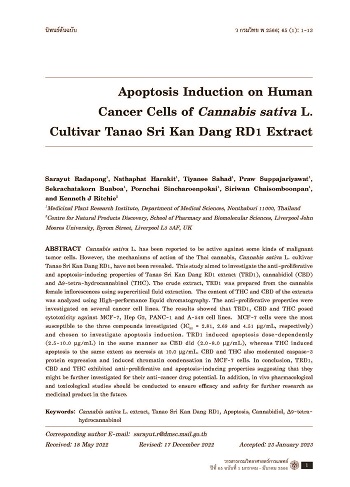Apoptosis Induction on Human Cancer Cells of Cannabis sativa L. Cultivar Tanao Sri Kan Dang RD1 Extract
Apoptosis Induction of Thai Cannabis; Tanao Sri Kan Dang RD1
Keywords:
Cannabis sativa L. extract, Tanao Sri Kan Dang RD1, Apoptosis, Cannabidiol, Δ9-tetrahydrocannabinolAbstract
Cannabis sativa L. has been reported to be active against some kinds of malignant tumor cells. However, the mechanisms of action of the Thai cannabis, Cannabis sativa L. cultivar, Tanao Sri Kan Dang RD1, have not been revealed. This study aimed to investigate the anti-proliferative and apoptosis-inducing properties of Tanao Sri Kan Dang RD1 extract (TRD1), cannabidiol (CBD) and Δ9-tetrahydrocannabinol (THC). The crude extract, TRD1, was prepared from the cannabis female inflorescences using supercritical fluid extraction. The content of THC and CBD of the extracts was analyzed using High-performance liquid chromatography. The anti-proliferative properties were investigated on several cancer cell lines. The results showed that TRD1, CBD and THC posed cytotoxicity against MCF-7, Hep G2, PANC-1 and A-549 cell lines. MCF-7 cells were the most susceptible to the three compounds investigated (IC50 = 2.81, 2.69 and 4.51 μg/mL, respectively) and chosen to investigate apoptosis induction. TRD1 induced apoptosis dose-dependently (2.5-10.0 μg/mL) in the same manner as CBD did (2.0-8.0 μg/mL), whereas THC induced apoptosis to the same extent as necrosis at 10.0 μg/mL. CBD and THC, also moderated caspase-3 protein expression and induced chromatin condensation in MCF-7 cells. In conclusion, TRD1,
CBD and THC exhibited anti-proliferative and apoptosis-inducing properties suggesting that they might be further investigated for their anti-cancer drug potential. In addition, in vivo pharmacological and toxicological studies should be conducted to ensure efficacy and safety for further research as medicinal product in the future.
References
McPartland JM. Cannabis systematics at the levels of family, genus, and species. Cannabis Cannabinoid Res 2018; 3(1): 203-12.
Saepae P. Get to know Thai marijuana and its medical purpose use. [online]. 2022; [cited 2022 Sep 20]; [10 screens]. Available from: URL: https://science.mahidol.ac.th/simple-science/2022/04/21/know-aboutthai-cannabis.
Small E, Cronquist A. A practical and natural taxonomy for Cannabis. Taxon 1976; 25: 405–35.
Bonini SA, Premoli M, Tambaro S, Kumar A, Maccarinelli G, Memo M, Mastinu A. Cannabis sativa: A comprehensive ethnopharmacological review of a medicinal plant with a long history. J Ethnopharmacol 2018; 227: 300-15.
Moreau M, Ibeh U, Decosmo K, Bih N, Yasmin-Karim S, Toyang N, et al. Flavonoid derivative of cannabis demonstrates therapeutic potential in preclinical models of metastatic pancreatic cancer. Front Oncol 2019; 9: 660. (9 pages).
Daris B, Verboten MT, Knez Z, Ferk P. Cannabinoids in cancer treatment: therapeutic potential and legislation. Bosnian J Basic Med Sci 2019; 19(1): 14-23.
Zhelyazkova M, Kirilov B, Momekov G. The pharmacological basis for application of cannabidiol in cancer chemotherapy. Pharmacia 2020; 67(4): 239-52.
Pfeffer CM, Singh ATK. Apoptosis: a target for anticancer therapy. Int J Mol Sci 2018; 19(2): 448. (10 pages).
Hanahan D, Weinberg RA. Hallmarks of cancer: the next generation. Cell 2011; 144(5): 646-74.
Kruidering M, Evan GI. Caspase-8 in apoptosis: the beginning of "the end"? IUBMB Life 2000; 50(2): 85-90.
Fink SL, Cookson BT. Apoptosis, pyroptosis, and necrosis: mechanistic description of dead and dying eukaryotic cells. Infec Immu 2005; 73(4): 1907-16.
Thongchin T, Marsud S, Thiemthieprat P, Ruengkhet S, Ontong S, Banyati P, et al. Development and method validation of cannabinoid contents In cannabis sativa L. leaves by ultra high performance liquid chromatography. Bull Med Sci 2021; 63(3): 506-23.
Jokić S, Jerković I, Pavić V, Aladić K, Molnar M, Kovač MJ, et al. Terpenes and cannabinoids in supercritical CO2 extracts of industrial hemp inflorescences: optimization of extraction, antiradical and antibacterial activity. Pharmaceuticals 2022; 15(9): 1117. (21 pages).
Radapong S, Suppajariyawat P, Phadungkit. M. Pharmacological and toxicological effects of cannabis. Bull Med Sci. 2020; 62(1): 219-32.
Suwan W. A variety of cannabis species. [online]. 2022; [cited 2022 Jan 17]; [4 screens]. Available from: URL: https://erp.mju.ac.th/acticleDetail.aspx?qid=1065.
Radapong S, Suppajariyawat P, Sahad T, Harnkit N, Phankhajon K, Primprai P, et al. Investigation of the cytotoxicity of Thai cannabis extracts on various cancer cell lines. Bull Med Sci 2021; 63(3): 456-66.
Takeda S, Okajima S, Miyoshi H, Yoshida K, Okamoto Y, Okada T, et al. Cannabidiolic acid, a major cannabinoid in fiber-type cannabis, is an inhibitor of MDA-MB-231 breast cancer cell migration. Toxicol Lett 2012; 214(3): 314-9.
Alexander A, Smith PF, Rosengren RJ. Cannabinoids in the treatment of cancer. Cancer Lett 2009; 285(1): 6-12.
Lukhele ST, Motadi LR. Cannabidiol rather than Cannabis sativa extracts inhibit cell growth and induce apoptosis in cervical cancer cells. BMC Complement Altern Med. 2016; 16(1): 335. (16 pages).
Shrivastava A, Kuzontkoski PM, Groopman JE, Prasad A. Cannabidiol induces programmed cell death in breast cancer cells by coordinating the cross-talk between apoptosis and autophagy. Mol Cancer Ther 2011; 10(7): 1161-72.
Caffarel MM, Sarrió D, Palacios J, Guzmán M, Sánchez C. Delta9-tetrahydrocannabinol inhibits cell cycle progression in human breast cancer cells through Cdc2 regulation. Cancer Res 2006; 66(13): 6615-21.
Sarafian TA, Tashkin DP, Roth MD. Marijuana smoke and Delta(9)-tetrahydrocannabinol promote necrotic cell death but inhibit Fas-mediated apoptosis. Toxicol Appl Pharmacol 2001; 174(3): 264-72.

Downloads
Published
How to Cite
Issue
Section
License
Copyright (c) 2023 BULLETIN OF THE DEPARTMENT OF MEDICAL SCIENCES

This work is licensed under a Creative Commons Attribution-NonCommercial-NoDerivatives 4.0 International License.



